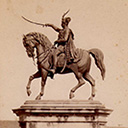0267 Public Sculpture in Zagreb in the Second Half of the 19th Century
Typology and Style of Monuments in the Urban Gesamtkunstwerk "Green Horseshoe" (Zelena potkova)
Identifiers (Article)
Abstract
The Zagreb Green Horseshoe, or Zelena potkova in Croatian, is an original urban evocation of the Ringstraße in Vienna that represents an effort to create a characteristic urban space during the era of Historicism. This distinctive 19th century urban project provided an appropriate setting for monuments and sculptural decoration. Squares, parks and main streets thus became a stage where contemporaries encountered monuments to personalities whose memory was to be preserved. The evocation of historical figures as a part of the collective memory is one of the fundamental ideas behind erecting monuments in any public place. Zagreb, as a national metropolis, favoured monuments dedicated to persons who recalled the nation’s glorious past and to highly regarded individuals, artists and poets. This paper focuses on thirteen monuments that were erected from 1866 to 1914 in this model part of the city and discusses issues related to the clients, the artists and the individuals to whom they were dedicated. The monuments that extend along the Zelena potkova can match the monuments on the Ringstraße, both examples are part of a common heritage from the reign of Franz Joseph I of Austria.
Statistics


License

This work is licensed under a Creative Commons Attribution-NonCommercial-NoDerivatives 4.0 International License.



